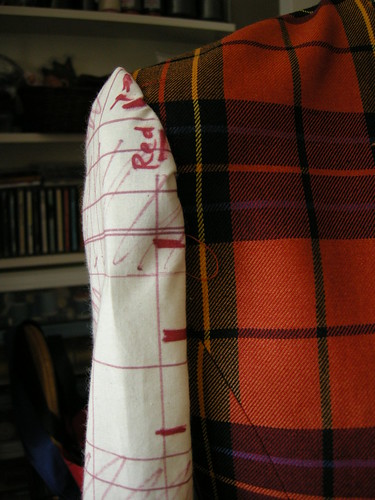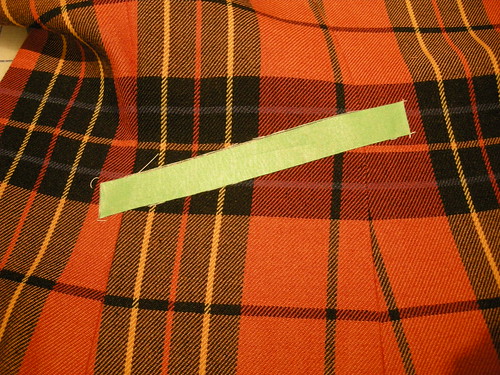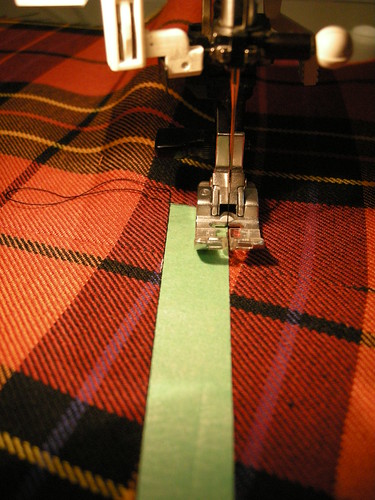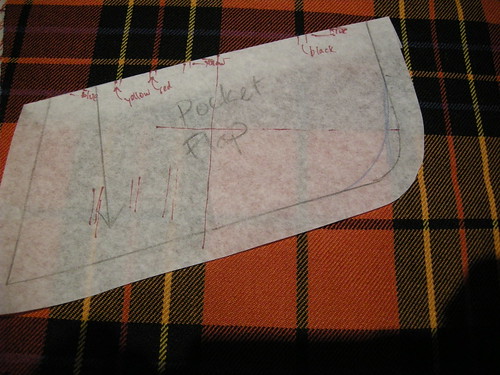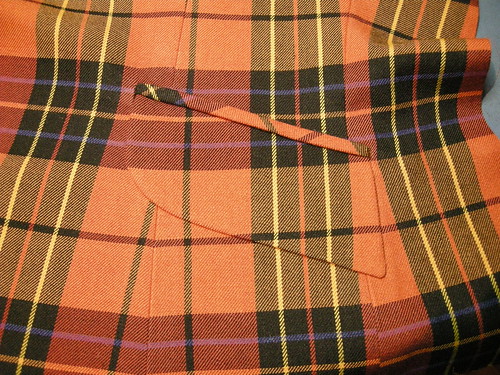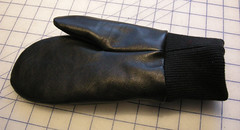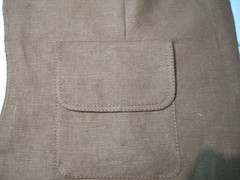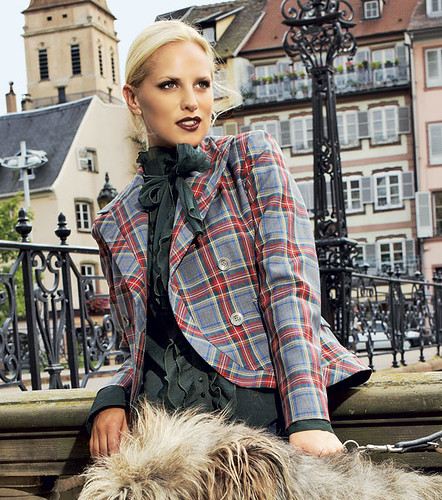I'm pleased to report that I have tamed the plaid at the sleeve ... phew! I did it by the most plodding approach possible. If any one of you reading this has a better and more elegant method I would love to hear about it. In the hopes of giving those of you who are better at this than I am a good laugh I will now illustrate my half-witted approach. In its defence, it did work...
Once I had the jacket body assembled I went back to my muslin sleeve (for once, my muslin was actually cut in plain muslin fabric) and took it apart. I went back to the traced sleeve pattern which, as you may recall from this post has plaid matching lines on it as supplied by Burda. Using the sleeve cap matching line I placed the muslin sleeve cap piece on the plaid fabric. With a Sharpie marker and a ruler, I drew the main elements of the plaid fabric right on the muslin. I then basted the muslin sleeve into the jacket body.
As you can see, the plaid decidedly does not match. Thankfully I was right not to quite trust those apparently-handy plaid-matching lines!
What to do? At first I thought I'd just measure the difference by which the sleeve needed to be shifted on the plaid. You can see that the plaid on the sleeve is consistently lower than the plaid on the jacket body - it was about 1.5cm (5/8") off. Then I thought it might be a bit tricky to transfer my knowledge onto the flat fabric for cutting - does the pattern piece need to be shifted up or down?? It is a bit confusing, that, even with this photo to remind me.
My solution was dead simple. Once again out came the Sharpie which I used to mark where the lines should be, right onto the muslin sleeve, like so.
I drew marks at the main horizontal elements, but also the vertical ones on the cap. I've tagged one of these lines "Red" so I would remember which part of the dark plaid box it was.
Once I had done that it was a simple matter to take the muslin sleeve out and transfer the knowledge I had gained through this exercise to the fabric.
The resulting sleeve, once set in, is pretty good, although not perfect at the vertical elements. I've read Kathleen Fasanella's posts on sleeve cap ease (she says it's bogus and uses a perfectly matched cap to illustrate - see part 1 and part 2). She says horizontal matching is impossible with sleeve cap ease, but I had no problem with the horizontal matching even though my sleeve pattern does have ease built in.
However, I'm still puzzling over how the tailors make a vertical line travel from the shoulder and directly down the front of the sleeve. In addition to the amazingly-matched sleeve cap in Kathleen's first sleeve cap ease post, check out the striped jacket in the first picture on this post from Made by Hand - the great Sartorial Debate - his right sleeve cap is flawless; the left one appears less so but I suspect this is only because of the angle of the photograph.
Maybe some day I will be able to manage this but for now, I have to settle with "good enough". Pictures will follow once I have the jacket a little further along.
Saturday, January 30, 2010
Textile-o-phile
Returning from a meeting this week I ambled into a store and came across some gorgeous wool shawls for 50% their regular price. I bought two. But one of them needed serious attention. Why would anyone think that a lovely 100% wool shawl already woven in riotous colour in paisley and hounds tooth pattern, with every edge a different woven border, would ALSO NEED TO BE EMBELLISHED ALL OVER WITH SEQUINS AND BEADS??!! Oy!
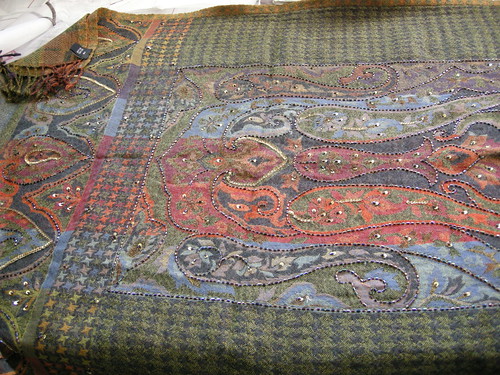 For 50% off I figured I could spend some quality time with my seam ripper, finding the ends of all the chain stitching....
For 50% off I figured I could spend some quality time with my seam ripper, finding the ends of all the chain stitching....This one has clunky embroidery on it - some of which has been removed. The whole thing is double-cloth - the other side is much lighter.
They will be so cozy in my chilly office with its "heritage" (i.e. single-paned metal mullioned) windows.
Sunday, January 24, 2010
Answering a couple of questions
There were a couple of questions in the comments to my last post (plaid pockets & flaps).
Ann's Fashion Studio asked about my basting thread. It is a Cansew product but I can't find it on their website. The label states "silk bonfil" and 40/3. It is a very smooth and strong thread. A little research on Google turned up the information that 40/3 is a common weight of glazed cotton thread for handsewing. It's heavier than regular sewing thread. Unlike the short staple cotton basting thread, which is designed to break easily for removal, this one doesn't shred. The cone holds 6,000 yards - I did say it was a lifetime supply!
Lisette M wanted to know if I had ever tried making a flapped pocket which has the flap sewn in overtop a single welt. I had never seen this type of pocket (but then I don't get out much). I checked on my favorite tailoring blog, Made by Hand - the Great Sartorial Debate and found out that while the "typical" pocket is the one I made, which is technically known as a "double jetted" pocket with flap, the single welt with flap may be substituted. There is a picture of one in this post. If I had done this type of pocket, the pocket flap would have been practically invisible since there would not have been the bias-cut jet to disturb the transition from jacket to matched flap. Oh well. In theory, one can tuck the flap to the inside of the double-jetted pocket to change up the look.
Ann's Fashion Studio asked about my basting thread. It is a Cansew product but I can't find it on their website. The label states "silk bonfil" and 40/3. It is a very smooth and strong thread. A little research on Google turned up the information that 40/3 is a common weight of glazed cotton thread for handsewing. It's heavier than regular sewing thread. Unlike the short staple cotton basting thread, which is designed to break easily for removal, this one doesn't shred. The cone holds 6,000 yards - I did say it was a lifetime supply!
Lisette M wanted to know if I had ever tried making a flapped pocket which has the flap sewn in overtop a single welt. I had never seen this type of pocket (but then I don't get out much). I checked on my favorite tailoring blog, Made by Hand - the Great Sartorial Debate and found out that while the "typical" pocket is the one I made, which is technically known as a "double jetted" pocket with flap, the single welt with flap may be substituted. There is a picture of one in this post. If I had done this type of pocket, the pocket flap would have been practically invisible since there would not have been the bias-cut jet to disturb the transition from jacket to matched flap. Oh well. In theory, one can tuck the flap to the inside of the double-jetted pocket to change up the look.
Friday, January 22, 2010
Plaid pockets & flaps
Continuing with my saga of the orange plaid jacket, I am pleased to report that progress IS being made. I have completed the pockets (double welt, with flaps) and thought I'd check in to show you how I made the welt pockets and flaps. BTW the flaps match. I'm pleased.
To sew the seams so the plaid would match, I used (more or less) the hand basting technique Mary Beth recently posted on her blog - "plaid matching by slip basting". It worked. I'm using my lifetime supply of basting thread, purchased on one of my recent trips to Montreal to suss out fabric stores for PR Weekend Canada (weekend of June 18-20, 2010). The lady in the store told me there were two types of basting thread - the kind that breaks and the kind that doesn't. She told me the Montreal tailors mostly favored the kind that does not break. You can give it a good pull, and it all comes out. I thought, if it is good enough for the Montreal tailors it is good enough for me, and bought this gigantic cone. Even though I say I hate hand sewing, I'm growing to like my basting thread.
I originally tried to mark the pocket openings using the basting thread - just a running stitch - but I am really not a very good hand sewer and I wasn't satisfied that my markings were precise enough. Then I had another idea, which I think was inspired by the thread on the Stitcher's Guild about stuff you use in the sewing room that isn't intended for sewing. We had some painter's masking tape in the house. I measured the exact size/shape of the pocket opening, cut two (mirror image) in tape, and applied them to the outside of the jacket fronts as shown here.
This created a highly visible and perfectly straight-edge guide for my machine basting to mark the pocket openings - once machine basted, the markings are visible on both sides.
At this point, I cut a generously sized bias patch of fabric to serve as the welts, and centred this over the marked box, on the right side of the jacket front.
Then, working from the wrong side, and using a 2mm stitch length, I stitched a hair inside the basting lines to secure the bias welt piece to the jacket front. I reinforced the ends of the box by going over the stitching with an even shorter (1mm) stitch. This helps with the next step, which is the most nerve-wracking - cutting through all layers, down the middle of the stitched box and into the corners. It is very important to clip right to the stitching at the corners, so that when you turn the welt to the inside, the corners will not pucker.
After I clipped, I trimmed the long clipped edges by a thread or two to make them even and as straight as possible, and to create a tiny gap between the cut edges. This is preparation for the fact that the bias welt piece is wrapped around these cut edges, as shown in the next photo. The result is that the cut edges reinforce and "fill out" the welt, and there is no bulk around the welt area.
I had previously trimmed out the seam allowances in the welt "box", from the wrong side, as shown here from the wrong side. Everything is done to maintain a uniform thickness, as much as possible.
After turning the welts to the inside and pressing them just so, the little triangles at the ends of the welt box need to be stitched down, and then it's time for the flaps.
I didn't cut the fashion fabric for the flaps until after my seams were sewn and pocket openings marked. I matched the plaid for the flaps by placing the tissue paper pattern piece over the markings on the jacket front, and literally drawing the lines of the plaid on it. To match the plaid I had to ignore the suggested grain line, and to avoid having a prominent dark leading edge on the curved corner of the flap, I re-drew the curve as you can see in this picture.
To sew the flaps, I used the same technique as shown in my tutorial. I used lining fabric for the facing of the flap to reduce bulk, and before sewing the lining to the interfaced flap, I trimmed all the seam edges of the flap lining by approximately 3mm or 1/8". This makes the lining layer smaller than the fashion fabric flap. In this photo, you can see how, when I pinned the edges together, it is obvious that the two layers are not the same size. I had to stretch the heck out of the lining layer while sewing along the seam lines.
Then I trimmed the outer flap layer seam allowances to about 3mm. If you do this there is absolutely no need to "clip" to the seam line. Once the flap is turned RS out, the tiny seam allowances squooshed nicely without pleating or puckering. And, best of all, the smaller lining layer means that the joining seam line rolls beautifully to the inside and the lining will never peek out.
I'm using an orange/blue silk fabric from stash for lining. I acquired many metres of this at a yard sale a few years ago. It pays to stash good quality fabric when you can find it for a great price!
After all components were assembled, here's my almost-completed pocket. If I had completely pandered to my matchy-matchy inclinations, I would probably have cut the welts on grain and tried to match them too, but I didn't and I think it's fine.
I won't be able to avoid cutting the sleeves for too much longer ... wish me luck!
To sew the seams so the plaid would match, I used (more or less) the hand basting technique Mary Beth recently posted on her blog - "plaid matching by slip basting". It worked. I'm using my lifetime supply of basting thread, purchased on one of my recent trips to Montreal to suss out fabric stores for PR Weekend Canada (weekend of June 18-20, 2010). The lady in the store told me there were two types of basting thread - the kind that breaks and the kind that doesn't. She told me the Montreal tailors mostly favored the kind that does not break. You can give it a good pull, and it all comes out. I thought, if it is good enough for the Montreal tailors it is good enough for me, and bought this gigantic cone. Even though I say I hate hand sewing, I'm growing to like my basting thread.
I originally tried to mark the pocket openings using the basting thread - just a running stitch - but I am really not a very good hand sewer and I wasn't satisfied that my markings were precise enough. Then I had another idea, which I think was inspired by the thread on the Stitcher's Guild about stuff you use in the sewing room that isn't intended for sewing. We had some painter's masking tape in the house. I measured the exact size/shape of the pocket opening, cut two (mirror image) in tape, and applied them to the outside of the jacket fronts as shown here.
This created a highly visible and perfectly straight-edge guide for my machine basting to mark the pocket openings - once machine basted, the markings are visible on both sides.
At this point, I cut a generously sized bias patch of fabric to serve as the welts, and centred this over the marked box, on the right side of the jacket front.
Then, working from the wrong side, and using a 2mm stitch length, I stitched a hair inside the basting lines to secure the bias welt piece to the jacket front. I reinforced the ends of the box by going over the stitching with an even shorter (1mm) stitch. This helps with the next step, which is the most nerve-wracking - cutting through all layers, down the middle of the stitched box and into the corners. It is very important to clip right to the stitching at the corners, so that when you turn the welt to the inside, the corners will not pucker.
After I clipped, I trimmed the long clipped edges by a thread or two to make them even and as straight as possible, and to create a tiny gap between the cut edges. This is preparation for the fact that the bias welt piece is wrapped around these cut edges, as shown in the next photo. The result is that the cut edges reinforce and "fill out" the welt, and there is no bulk around the welt area.
I had previously trimmed out the seam allowances in the welt "box", from the wrong side, as shown here from the wrong side. Everything is done to maintain a uniform thickness, as much as possible.
After turning the welts to the inside and pressing them just so, the little triangles at the ends of the welt box need to be stitched down, and then it's time for the flaps.
I didn't cut the fashion fabric for the flaps until after my seams were sewn and pocket openings marked. I matched the plaid for the flaps by placing the tissue paper pattern piece over the markings on the jacket front, and literally drawing the lines of the plaid on it. To match the plaid I had to ignore the suggested grain line, and to avoid having a prominent dark leading edge on the curved corner of the flap, I re-drew the curve as you can see in this picture.
To sew the flaps, I used the same technique as shown in my tutorial. I used lining fabric for the facing of the flap to reduce bulk, and before sewing the lining to the interfaced flap, I trimmed all the seam edges of the flap lining by approximately 3mm or 1/8". This makes the lining layer smaller than the fashion fabric flap. In this photo, you can see how, when I pinned the edges together, it is obvious that the two layers are not the same size. I had to stretch the heck out of the lining layer while sewing along the seam lines.
Then I trimmed the outer flap layer seam allowances to about 3mm. If you do this there is absolutely no need to "clip" to the seam line. Once the flap is turned RS out, the tiny seam allowances squooshed nicely without pleating or puckering. And, best of all, the smaller lining layer means that the joining seam line rolls beautifully to the inside and the lining will never peek out.
I'm using an orange/blue silk fabric from stash for lining. I acquired many metres of this at a yard sale a few years ago. It pays to stash good quality fabric when you can find it for a great price!
After all components were assembled, here's my almost-completed pocket. If I had completely pandered to my matchy-matchy inclinations, I would probably have cut the welts on grain and tried to match them too, but I didn't and I think it's fine.
I won't be able to avoid cutting the sleeves for too much longer ... wish me luck!
Thursday, January 14, 2010
Sewing Tutorials
It's fantastic how the www works, really. Until about 5 years ago I used to sew in solitary splendor although obviously I knew there were others out there. Then I joined PatternReview and started reading blogs. Over time, I came to realize that through communication on the internet, I had improved my sewing and been introduced to a whole lot of new sewing information and resources.
Among which are on-line sewing tutorials. The best collection of them that I know of can be found on Sigrid's blog. I was thrilled when Sigrid contacted me to ask if she could include a few of my own photo-tutorials on her site. In future I'll post tutorials on this blog as they occur to me. For now, here's a list of the ones I've prepared and links to Flickr where you can read through them. Enjoy! If you have any questions about these techniques, feel free to ask.
Faced fly front zipper. This is one of those construction methods that looks like it is impossible. But it is not!
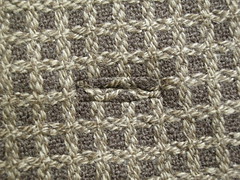 Bound buttonholes. The method I illustrated is actually overkill - you don't need to sew all those parallel basting lines because once you sew around the box and slash the opening, cutting right to the corners, the patch forms perfect "lips" when it wraps over the cut edges.
Bound buttonholes. The method I illustrated is actually overkill - you don't need to sew all those parallel basting lines because once you sew around the box and slash the opening, cutting right to the corners, the patch forms perfect "lips" when it wraps over the cut edges.
I'm going to be making bound buttonholes in my plaid jacket and will update the tutorial then.
Beltloops. This method doesn't rely on remembering to sew one end of the loop into the waistband (I always forget to do this!), and it doesn't require topstitching the loop to the garment - all attaching stitches are concealed and there are no raw edges. More magic!

Bellows patch pocket. I made this tutorial to translate Burda's somewhat incoherent instructions into something understandable. The bellows are decorative on my linen jacket, but this technique would work for real cargo pockets as well.
Leather mittens. Mittens are sooo much warmer than gloves, and leather mittens are windproof and look nice too. These are made from an old leather skirt found in a thrift shop. The tutorial includes a birds-eye view of my pattern as well as all construction techniques.
Lined pocket flaps. This is another technique I'll use on my plaid jacket. To reduce bulk, use lining fabric to face the flap, and to ensure the edges are hidden, make sure the lining layer is slightly smaller than the outer flap. The seams will roll automatically to the wrong side.
Among which are on-line sewing tutorials. The best collection of them that I know of can be found on Sigrid's blog. I was thrilled when Sigrid contacted me to ask if she could include a few of my own photo-tutorials on her site. In future I'll post tutorials on this blog as they occur to me. For now, here's a list of the ones I've prepared and links to Flickr where you can read through them. Enjoy! If you have any questions about these techniques, feel free to ask.
Faced fly front zipper. This is one of those construction methods that looks like it is impossible. But it is not!
 Bound buttonholes. The method I illustrated is actually overkill - you don't need to sew all those parallel basting lines because once you sew around the box and slash the opening, cutting right to the corners, the patch forms perfect "lips" when it wraps over the cut edges.
Bound buttonholes. The method I illustrated is actually overkill - you don't need to sew all those parallel basting lines because once you sew around the box and slash the opening, cutting right to the corners, the patch forms perfect "lips" when it wraps over the cut edges. I'm going to be making bound buttonholes in my plaid jacket and will update the tutorial then.
Beltloops. This method doesn't rely on remembering to sew one end of the loop into the waistband (I always forget to do this!), and it doesn't require topstitching the loop to the garment - all attaching stitches are concealed and there are no raw edges. More magic!

Bellows patch pocket. I made this tutorial to translate Burda's somewhat incoherent instructions into something understandable. The bellows are decorative on my linen jacket, but this technique would work for real cargo pockets as well.
Leather mittens. Mittens are sooo much warmer than gloves, and leather mittens are windproof and look nice too. These are made from an old leather skirt found in a thrift shop. The tutorial includes a birds-eye view of my pattern as well as all construction techniques.
Lined pocket flaps. This is another technique I'll use on my plaid jacket. To reduce bulk, use lining fabric to face the flap, and to ensure the edges are hidden, make sure the lining layer is slightly smaller than the outer flap. The seams will roll automatically to the wrong side.
Tuesday, January 5, 2010
Did I not promise plaid?
Well, they do say that if you fall off, you should get right back on ... whatever it was you fell off. I hope I'm in the process of recovering from the fall as I work on my new latest project, the plaid Burda jacket, #114 from the January, 2009 issue.
Here's Burda's version.
I loved this as soon as I saw it and it has been lurking on my "to sew" list for a year now. Birgitte was very prompt in February with her version, also in plaid and just gorgeous in every way. For me, new ideas (plaid double-breasted jacket, bias plaid trim, diagonal bound buttonholes, very quirky collar/lapels) need time to percolate. So a year later, I'm finally getting around to it.
At some point in the year a piece of fabric buried in the stash called to me. It called LOUDLY. It said it was a plaid ... no - it SHOUTED that it was A PLAID! And it thought it could be this jacket.
Matching the plaid on a princess seamed jacket with set in sleeves is not a task for the faint of heart. I have a long history with plaid and I am firmly in the slightly manic matchmaker camp of sewers. Another of my school home ec projects was a tailored wool coat. The teacher instructed us to go out and find a pattern for a coat or jacket and wool fabric. She suggested plaid might not be a good idea, but if we fell in love with a plaid, to make sure it was an even plaid. From a document on plaid at the University of Kentucky website:
NOTE: For the beginner, an even plaid is the
easiest to work with and will build one’s
confidence."
You already know from this post that as a beginning sewer, I would sometimes pick challenging school projects. In this case, I ended up with a plaid which was uneven in both directions ("Different from left to right and above and below a dominant line"). Just as my grade 8 teacher must have done, my grade 12 teacher sighed when she saw it, and then, bless her heart, she methodically started to show me how to plan the garment so I could match the plaid at every possible juncture. Everything was cut single layer and as I recall, even the lips of the bound buttonholes matched the coat fronts. Success with uneven plaid is truly a confidence-building experience.
But I digress.
A couple of days ago I started trying to figure out how the Burda jacket pattern would work with my plaid. After moving some furniture around, I laid out the fabric on the floor, single layer, and tried various placements. The crucial places to match plaid are the CF and CB (intersecting horizontal and vertical elements should meet precisely on vertical seams/edges). The CB of the collar can usually be made to match with the CB of the jacket body. Obviously wherever there are shaping seams, the plaid design will distort somewhat at the seams, but despite this thought has to be given to how the main elements of the plaid will interact at all vertical seams in the body of the jacket, and at the armscye-sleeve seam - the goal being to keep the general rhythm of the plaid as constant as possible, recognizing that perfection is impossible (for example, the plaid will not match at the shoulders unless you have an extraordinarily symmetrical pattern, which mine isn't).
It probably should go without saying, but I'll say it anyhow, that the matching point is the seam line and not the cut edge of the pieces. It's helpful to have that line drawn on your pattern pieces when laying out the pattern on the fabric.
-- Oh, did I not mention that the plaid was orange, as well as loud?
When this photo was taken I was toying with the idea that the CF and CB should be on the dominant dark vertical line of my more-or-less even plaid. If you click on the photo to enlarge, you can see I had darkened the grain lines, critical seam lines, and CF line. The CB neck point is lying so the seam line is exactly in the middle of the dominant vertical line of the plaid.
Horizontally, I was paying attention to the built-in Burda horizontal plaid-matching lines (you can see them in the body pieces below the waist, and on the front and sleeve at the armscye near the notch). I also thought about where the bottom of the jacket would hit on the plaid. Because there's a bottom band which will be on the bias, I concluded this is less important - it so happened that the dominant horizontal element is just above the band which seems OK to me.
The jacket has welt pockets with flaps and so I will also try to match the flaps to the jacket body. Because the pocket opening lies on 3 pieces (front, side front and side back), it will be impossible to completely match the flap to the body. The important part is obviously the front. I therefore paid attention to matching the vertical as well as horizontal plaid lines as closely as possible at the point where the pocket markings cross from front to side-front.
Eventually I realized that the WOF jacket was cut with the CF falling on a non-dominant vertical line and I decided that would work better. So I shifted the pieces over and now the dark vertical in the middle of the orange lines is at the CB and CF. It seems more subtle, that is if anything made in orange plaid could be subtle.
The real matching challenge in this jacket will be the armscye-sleeve seam which always drives me nuts, but I'm also thinking ahead to the interesting question whether (as Birgitte did, whether by accident or design) I can get at least some elements on the bias edge of the lapel to match the same elements on the jacket fronts. (Or whether I care...) For now, I've only cut out the body pieces and under collar. Once the body of the jacket is constructed I can make more informed decisions about how to cut the sleeves and other pieces.
I'll leave off with a sneak preview of how the plaid intersects at the front princess seams. This is just pinned together, but isn't it exciting?
Here's Burda's version.
I loved this as soon as I saw it and it has been lurking on my "to sew" list for a year now. Birgitte was very prompt in February with her version, also in plaid and just gorgeous in every way. For me, new ideas (plaid double-breasted jacket, bias plaid trim, diagonal bound buttonholes, very quirky collar/lapels) need time to percolate. So a year later, I'm finally getting around to it.
At some point in the year a piece of fabric buried in the stash called to me. It called LOUDLY. It said it was a plaid ... no - it SHOUTED that it was A PLAID! And it thought it could be this jacket.
Matching the plaid on a princess seamed jacket with set in sleeves is not a task for the faint of heart. I have a long history with plaid and I am firmly in the slightly manic matchmaker camp of sewers. Another of my school home ec projects was a tailored wool coat. The teacher instructed us to go out and find a pattern for a coat or jacket and wool fabric. She suggested plaid might not be a good idea, but if we fell in love with a plaid, to make sure it was an even plaid. From a document on plaid at the University of Kentucky website:
"An even (balanced) plaid has the same lines,
spaces, and colors on the left and right and the
same lines, spaces, and colors above and below
a center or dominant line. Even plaids will
match in both the lengthwise and crosswise
directions.
same lines, spaces, and colors above and below
a center or dominant line. Even plaids will
match in both the lengthwise and crosswise
directions.
NOTE: For the beginner, an even plaid is the
easiest to work with and will build one’s
confidence."
You already know from this post that as a beginning sewer, I would sometimes pick challenging school projects. In this case, I ended up with a plaid which was uneven in both directions ("Different from left to right and above and below a dominant line"). Just as my grade 8 teacher must have done, my grade 12 teacher sighed when she saw it, and then, bless her heart, she methodically started to show me how to plan the garment so I could match the plaid at every possible juncture. Everything was cut single layer and as I recall, even the lips of the bound buttonholes matched the coat fronts. Success with uneven plaid is truly a confidence-building experience.
But I digress.
A couple of days ago I started trying to figure out how the Burda jacket pattern would work with my plaid. After moving some furniture around, I laid out the fabric on the floor, single layer, and tried various placements. The crucial places to match plaid are the CF and CB (intersecting horizontal and vertical elements should meet precisely on vertical seams/edges). The CB of the collar can usually be made to match with the CB of the jacket body. Obviously wherever there are shaping seams, the plaid design will distort somewhat at the seams, but despite this thought has to be given to how the main elements of the plaid will interact at all vertical seams in the body of the jacket, and at the armscye-sleeve seam - the goal being to keep the general rhythm of the plaid as constant as possible, recognizing that perfection is impossible (for example, the plaid will not match at the shoulders unless you have an extraordinarily symmetrical pattern, which mine isn't).
It probably should go without saying, but I'll say it anyhow, that the matching point is the seam line and not the cut edge of the pieces. It's helpful to have that line drawn on your pattern pieces when laying out the pattern on the fabric.
-- Oh, did I not mention that the plaid was orange, as well as loud?
When this photo was taken I was toying with the idea that the CF and CB should be on the dominant dark vertical line of my more-or-less even plaid. If you click on the photo to enlarge, you can see I had darkened the grain lines, critical seam lines, and CF line. The CB neck point is lying so the seam line is exactly in the middle of the dominant vertical line of the plaid.
Horizontally, I was paying attention to the built-in Burda horizontal plaid-matching lines (you can see them in the body pieces below the waist, and on the front and sleeve at the armscye near the notch). I also thought about where the bottom of the jacket would hit on the plaid. Because there's a bottom band which will be on the bias, I concluded this is less important - it so happened that the dominant horizontal element is just above the band which seems OK to me.
The jacket has welt pockets with flaps and so I will also try to match the flaps to the jacket body. Because the pocket opening lies on 3 pieces (front, side front and side back), it will be impossible to completely match the flap to the body. The important part is obviously the front. I therefore paid attention to matching the vertical as well as horizontal plaid lines as closely as possible at the point where the pocket markings cross from front to side-front.
Eventually I realized that the WOF jacket was cut with the CF falling on a non-dominant vertical line and I decided that would work better. So I shifted the pieces over and now the dark vertical in the middle of the orange lines is at the CB and CF. It seems more subtle, that is if anything made in orange plaid could be subtle.
The real matching challenge in this jacket will be the armscye-sleeve seam which always drives me nuts, but I'm also thinking ahead to the interesting question whether (as Birgitte did, whether by accident or design) I can get at least some elements on the bias edge of the lapel to match the same elements on the jacket fronts. (Or whether I care...) For now, I've only cut out the body pieces and under collar. Once the body of the jacket is constructed I can make more informed decisions about how to cut the sleeves and other pieces.
I'll leave off with a sneak preview of how the plaid intersects at the front princess seams. This is just pinned together, but isn't it exciting?
Friday, January 1, 2010
Burda 7731 Coat - sad, sad news
After a short, much too labour-intensive and difficult existence, Burda 7731 Coat, latest sewing project of The Sewing Lawyer, was removed from life support on New Years Day, 2010.
Burda 7731 was a lovely idea - a long, elegant, flared overcoat with cut-on sleeves, a high and sinuous pleated collar, cute button-on belt and in-seam pockets. Burda 7731 was an eagerly-anticipated addition to the Sewing Lawyer closet - the fabric a lustrous and waterproof taffeta in iridescent teal, the lining a satiny and elegant ikat-like floral print. With light and warm interlining of Thinsulate, Burda 7731 would have been the go-to workhorse of a winter coat for wet/snowy workdays. Burda 7731 will be sadly missed.
Burda 7731 Coat had a difficult birth. A few hours into its existence, a congenital pattern defect needing immediate, experimental surgery was discovered. The surgery was successful but Burda 7731 would continue to struggle. Sadly, the Sewing Lawyer's choices for Burda 7731 only added to its (and her) misery. The in-seam pockets were a disaster given the thinness of the fabric and the lack of any stabilizing for the pocket opening. Further surgery was needed to install piping at the openings. The fabric was also constantly prone to puckering at the seams no matter how much The Sewing Lawyer adjusted stitch length and tension, used "taut sewing" (holding the fabric behind and in front of the needle, applying tension to the fabric as it passes through the needle but without pulling it), and labour-intensively edge stitched each and every seam. This is why even though Burda 7731 Coat was within striking distance of actually being finished, there will be no photos.* The Sewing Lawyer has her reputation to uphold and Burda 7731 Coat was, at the end, a sad wrinkled thing.
Although The Sewing Lawyer is one seriously stubborn person with lots of experience in curing apparently-fatal defects which have cropped up in many of the older sibling sewing projects of Burda 7731, it became clear with the end of 2009 and in the clear (okay, snowy and gray) light of January 1, 2010, that Burda 7731 would never recover, that further surgery would be extremely painful for all concerned, and that it would not likely succeed. And that is why, after much anxious thought and with sincere regret for the iridescent teal taffeta-like fabric and all that sewing time which are now lost forever, The Sewing Lawyer decided that she had to let go.
R.I.P. Burda 7731 coat.
* As Vicki has pointed out, a picture is available on my Pattern Review. That's for the scientific interest of other sewers who need to know why they must run far away from Burda 7731 so as to avoid having this fatal condition attack one of their own sewing projects... But the point of this post is only to mourn the brief existence of Burda 7731 Coat. (Closed casket, ya know?)
Burda 7731 was a lovely idea - a long, elegant, flared overcoat with cut-on sleeves, a high and sinuous pleated collar, cute button-on belt and in-seam pockets. Burda 7731 was an eagerly-anticipated addition to the Sewing Lawyer closet - the fabric a lustrous and waterproof taffeta in iridescent teal, the lining a satiny and elegant ikat-like floral print. With light and warm interlining of Thinsulate, Burda 7731 would have been the go-to workhorse of a winter coat for wet/snowy workdays. Burda 7731 will be sadly missed.
Burda 7731 Coat had a difficult birth. A few hours into its existence, a congenital pattern defect needing immediate, experimental surgery was discovered. The surgery was successful but Burda 7731 would continue to struggle. Sadly, the Sewing Lawyer's choices for Burda 7731 only added to its (and her) misery. The in-seam pockets were a disaster given the thinness of the fabric and the lack of any stabilizing for the pocket opening. Further surgery was needed to install piping at the openings. The fabric was also constantly prone to puckering at the seams no matter how much The Sewing Lawyer adjusted stitch length and tension, used "taut sewing" (holding the fabric behind and in front of the needle, applying tension to the fabric as it passes through the needle but without pulling it), and labour-intensively edge stitched each and every seam. This is why even though Burda 7731 Coat was within striking distance of actually being finished, there will be no photos.* The Sewing Lawyer has her reputation to uphold and Burda 7731 Coat was, at the end, a sad wrinkled thing.
Although The Sewing Lawyer is one seriously stubborn person with lots of experience in curing apparently-fatal defects which have cropped up in many of the older sibling sewing projects of Burda 7731, it became clear with the end of 2009 and in the clear (okay, snowy and gray) light of January 1, 2010, that Burda 7731 would never recover, that further surgery would be extremely painful for all concerned, and that it would not likely succeed. And that is why, after much anxious thought and with sincere regret for the iridescent teal taffeta-like fabric and all that sewing time which are now lost forever, The Sewing Lawyer decided that she had to let go.
R.I.P. Burda 7731 coat.
* As Vicki has pointed out, a picture is available on my Pattern Review. That's for the scientific interest of other sewers who need to know why they must run far away from Burda 7731 so as to avoid having this fatal condition attack one of their own sewing projects... But the point of this post is only to mourn the brief existence of Burda 7731 Coat. (Closed casket, ya know?)
Subscribe to:
Posts (Atom)

